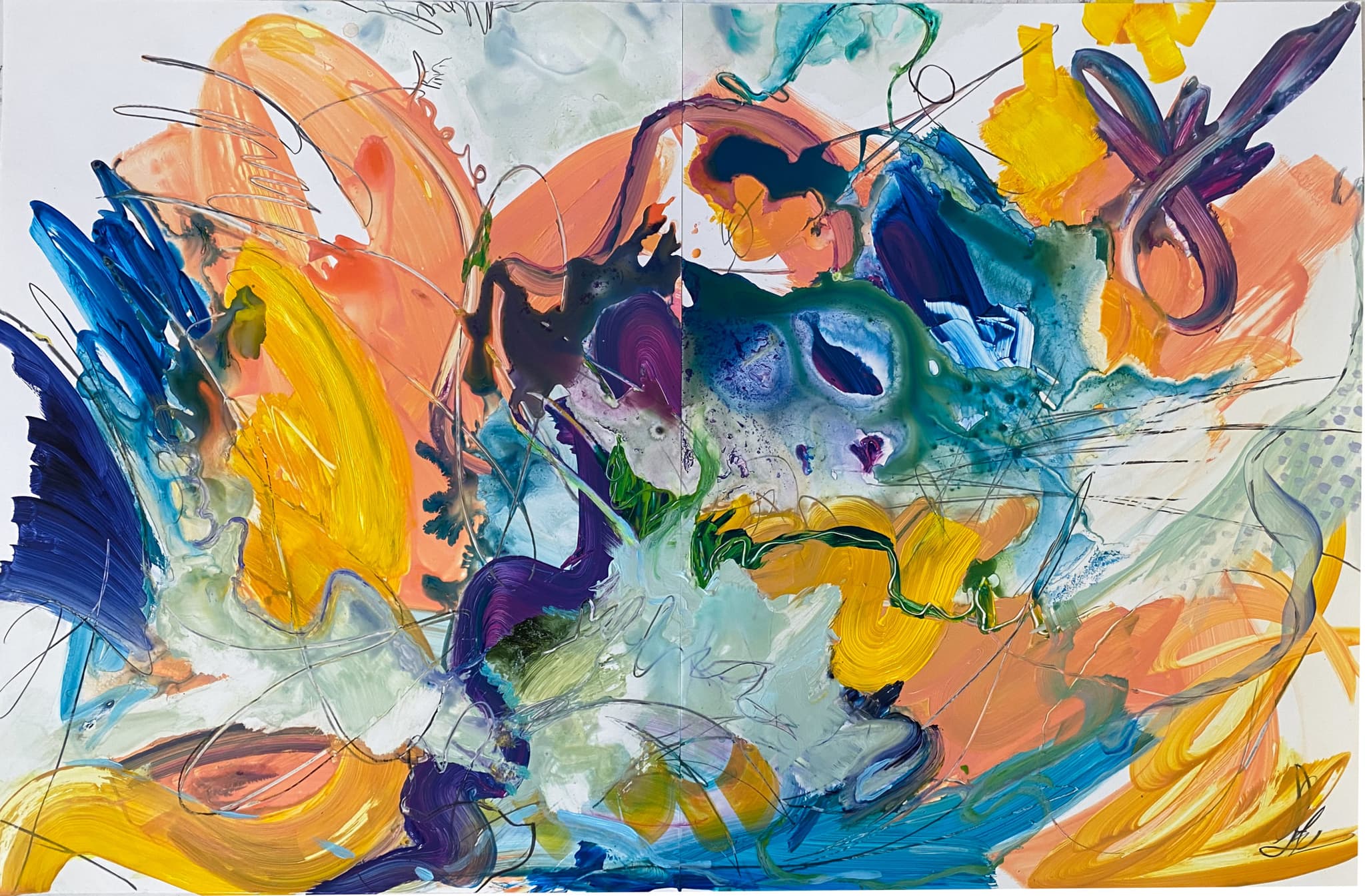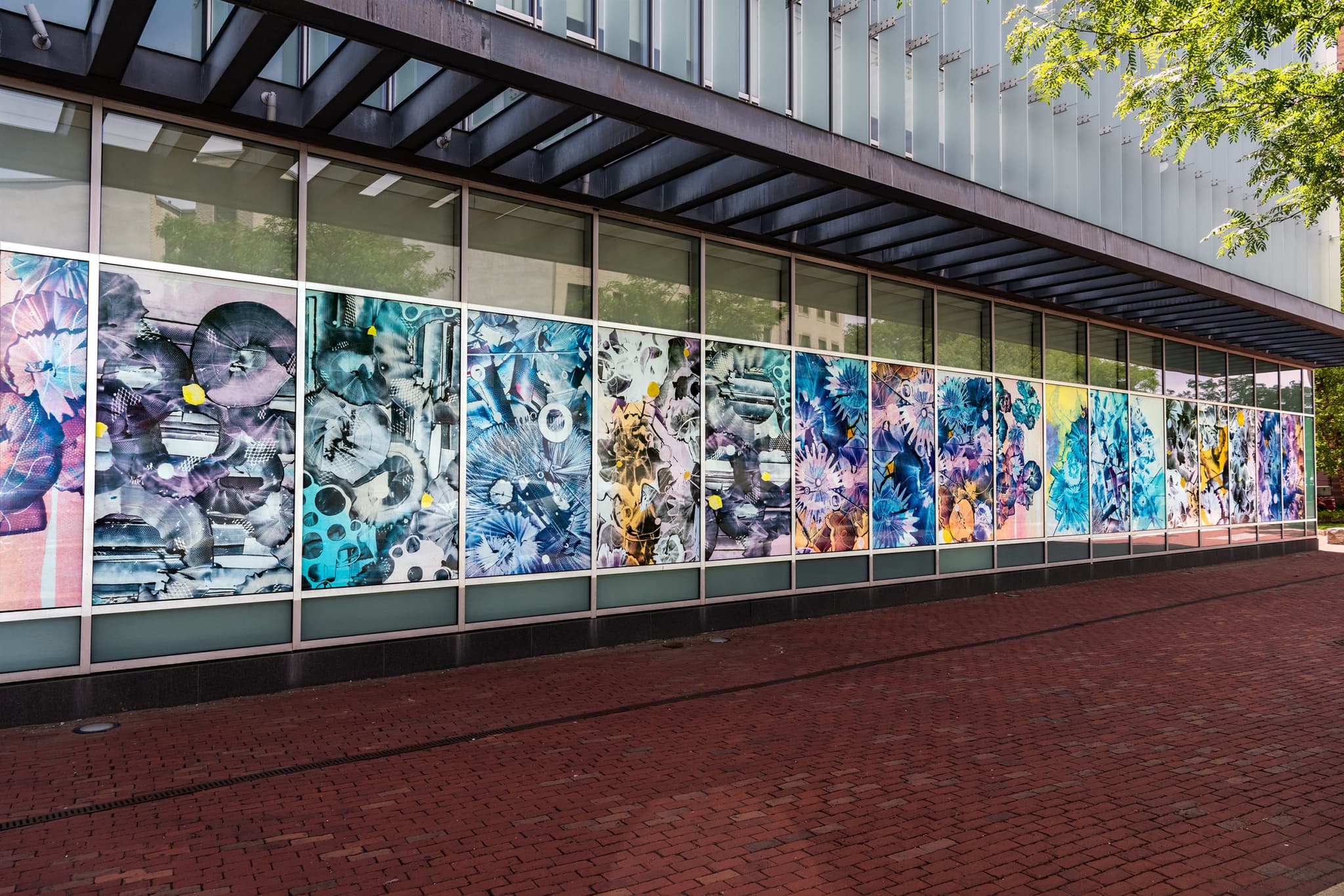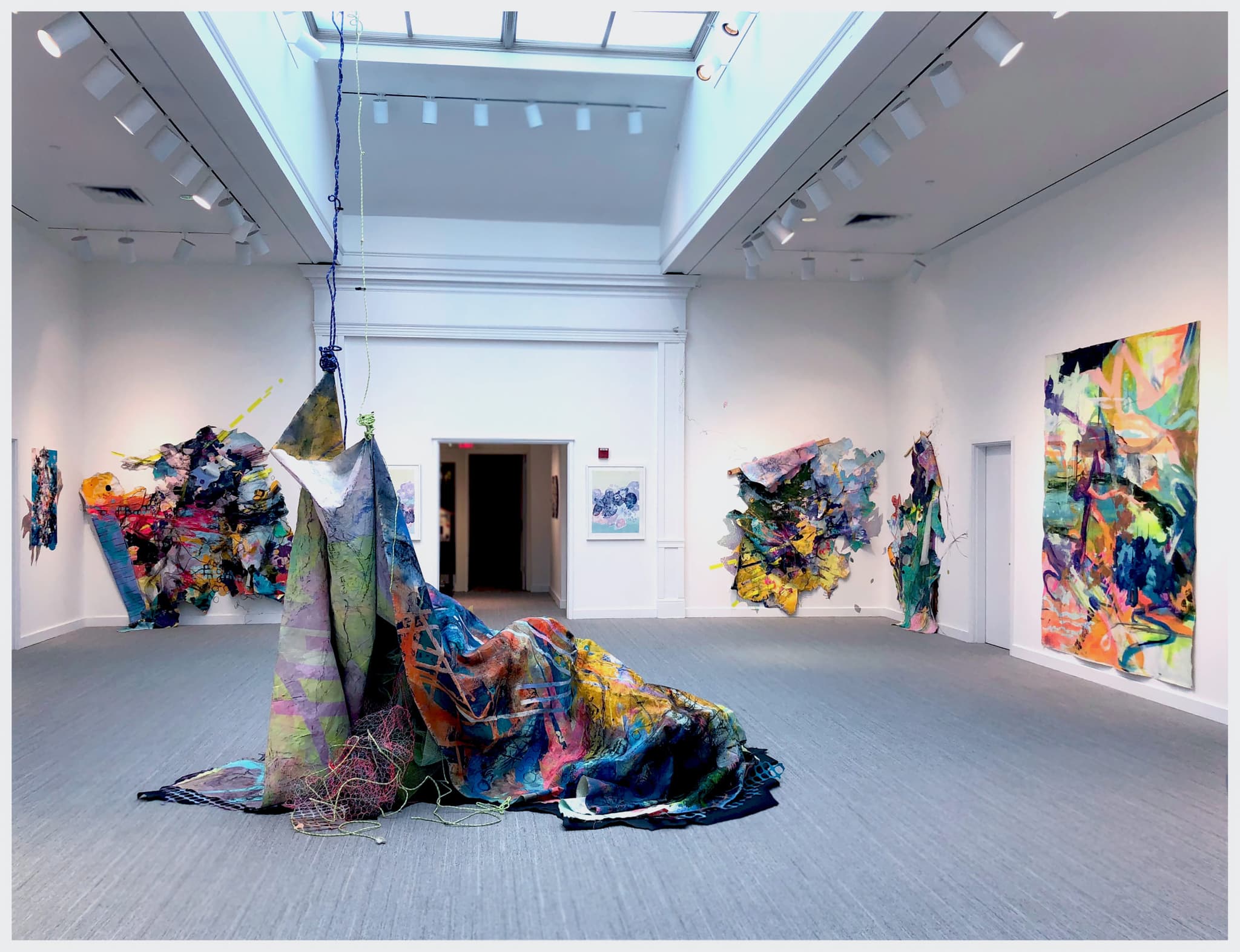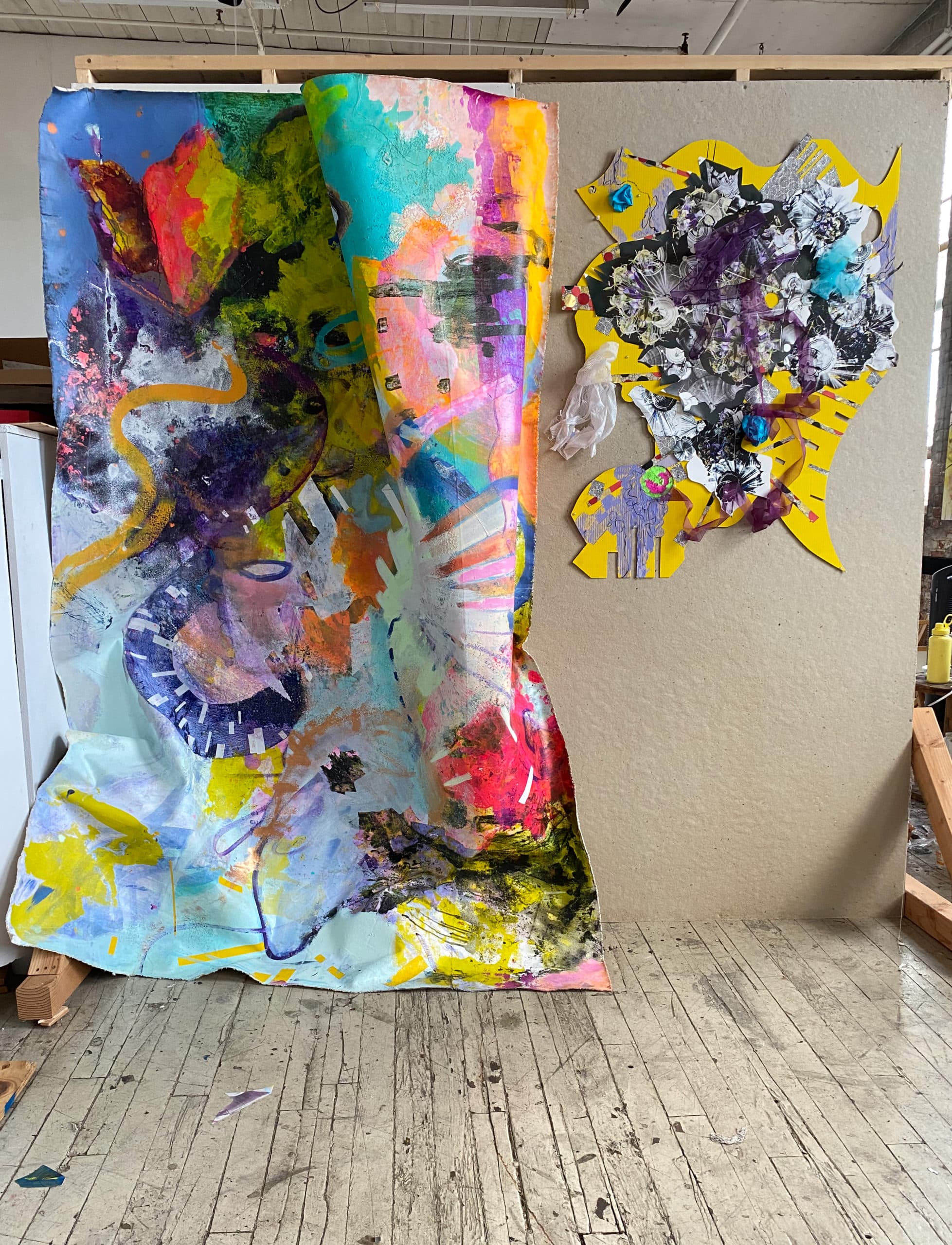Cicely Carew’s paintings are an exercise in new ways to sense. No matter the individual work, a choreography of material, composition, layering, and an enduring contemplation of the nature of existence converge in space and time to offer a profound moment of being with art. When we live in such acute and collective isolation, craving connection with others, Carew’s paintings are a precious space for everyone to feel together the resiliency, freedom, and joy undergirding how the artist moves through the world.
I visited Carew at her studio in Waltham in October 2020, a month before the watershed 2020 United States presidential election and when it felt safe (at least then) to see people not over a screen. What-ifs, anxiety, and hope saturated the back-ground of our nearly two-hour discussion. In hindsight, things have both changed and not really changed since. Nevertheless, I still find Carew’s effervescent reflections on life and art from that moment in time to resonate with the present—and likely the future—as we continue searching for paths away from precarity and towards wholeness. The following conversation has been edited and condensed.
Mallory A. Ruymann: It feels novel to be in a studio after months of looking at art online. How was your transition back into the space of art IRL?
Cicely Carew: I felt uncertainty coming back into the studio after self-isolation. At home, I could only make art on the computer. When I made the initial gesture for my first post-lockdown work, For what is bitter and what is sweet is all for my growing, I questioned if I knew what I was doing. Isn’t that the remarkable part of the process—when you push through uncertainty and trust that you have all of the tools at your disposal?
MAR: For what is bitter exists on a more intimate scale than other works I have seen. I’m thinking specifically of your show at Simmons, where paintings were so materially expressive they tumbled into sculpture.
CC: When I get really material-heavy, like in the work at Simmons, I simply play and use my whole body to create, fully extending my limbs and weight. My practice is grounded in the application of layers—adding, subtracting, working with my lexicon, playing with the painting’s grammar, if you will. In addition to thinking a lot about Suprematism, Modernism, Abstract-Expressionism, and jazz when I work, I think about the artistic traditions of my ancestry—via 23andMe, I’m pan-African and Latina, with Mayan ancestry—and how weaving, color, pattern, texture, and ritual relate to synchronicities in my process. Though I don’t have direct contact with these traditions because I’m adopted, I’m fascinated by the mystery of my ancestors and how they might unconsciously inform my use of layering as a means to contemplate and destabilize hierarchies.
MAR: I want to contextualize the uncertainty you mentioned. The art market has manufactured a narrow margin for artists to function successfully within, even influencing what museums can show. All things considered, few women BIPOC artists are market-tested and approved, so there’s a demand for work that looks like known quantities. How do you navigate making on your own terms?
CC: Being both a woman and a Black artist, the space appears to be limited in some ways. There was already a demand for Black artists to craft a certain message in order to be recognized, which doesn’t resonate with me, and now the way our voices are being commodified makes the current openness feel temporary. Institutions are putting the onus on us, again, to fix what’s not ours to hold. Continuing to make work we believe in is a way to overcome 500 years of a system that is ultimately not our creation. I want the freedom to make work my way—for it to be a conduit of healing and unapologetic joy. I have to believe that my way is enough because I’m working with purpose. I want to liberate myself from the idea that I am separate, and that means accepting everything for what is bitter and what is sweet.

Cicely Carew, For what is bitter and what is sweet is all for my growing, 2020. Acrylic on Yupo paper, 26” x 40”. Artwork courtesy of the artist.
MAR: I do believe there are ways to expand who gets to show what. We just have to do the work. Curators are trained to evaluate art based on an antiquated art history and a contrived concern with the artist’s identity—a formula that feels far from the individual. When I discuss overcoming these systemic conditions with colleagues, one tool that keeps coming up is the impor-tance of authentic responses, such as those I feel when I look at your work.
CC: I trust the intelligence of the viewer. When other people believe in what you’re doing, that’s magic. It’s not the poof, abracadabra kind of magic. It’s the “I’m living within the now, and I believe the thing in front of me” magic. More so than anything, Buddhist philosophy influences my work, which I hope touches on that nameless, formless thing behind all of the movement, the mess, the stuff of life.
MAR: Would you say that mindfulness tools are embedded within both the act of the practice and its physical manifestations?
CC: In my other life, I’ve been a yoga teacher and Pilates instructor, and I’ve found bodily wellness in trying new things. I’m fascinated with proprioception [the perception of the body’s position in space] and interoception [the perception of sensations inside the body]. In my artwork, I investigate ways we can sense beyond what one sees or touches. Material play in the practice is one way to access new ways of sensing the world and being in it, not of it.

Self-portraits courtesy of the artist.
MAR: Let’s talk about the titles of your work because I think of them as a kind of subtext related to mindfulness.
CC: I used to not give titles much attention—I felt that naming was also trapping. I’ve recently come back to the significance of titles. I’m inspired by simple phrases from my teachers Mooji, Marianne Williamson, Eckhart Tolle, Ram Dass, Toni Morrison, bell hooks, Matt Kahn, Ernest Holmes, Rumi, and Alan Watts. I’ll often say a phrase out loud from one of these thinkers for a while in the context of a work to see if it resonates.
MAR: Maybe we can think of the title as a mantra? With Eurocentric medieval art, for example, a text- image-spirituality triangle worked together to access something beyond the artist.
CC: The triangle is there, and the titles are an extension of the work’s spiritual expression. Even before I begin something, I say a prayer—“I’m here. I’m available. I’m open.” With each gesture, I’m also praying for consciousness and healing for myself and the world. I would even say I situate my practice within Spiritualist traditions, like those of Wassily Kandinsky, Hilma af Klint, and Jack Whitten.
MAR: Even with the title leading the way, people will inevitably see what they want. Thinking about “audience” a bit more, do they have a shape or name?
CC: Not particularly. I think I make work in devotion to humanity. I recently listened to a lecture about revolution and how modern society has separated us from our whole-ness. In my art, I am healing myself back to wholeness, to the person I know is there—the badass girl who trusted and loved herself and existed within a state of freedom. If people see my art, see my freedom, and know that I love myself, maybe they choose to liberate themselves that same way too. Spirituality, then, for me, is an inner journey to remember the self and make peace with ego. When I think about the era we live in, I see an awakening of self that has been suppressed because the fully realized self is dangerous.

Cicely Carew, What Lies Within, window installation view at Northeastern University, 2017-2020. 9’ x 120’. Photo courtesy of the artist.

“What They See: Cicely Carew,” installation view, Simmons University Trustman Art Gallery, Boston, 2020. Photos courtesy of the artist.
MAR: I often feel that the art world purposefully makes the self less dangerous by devaluing the labor of artists and cultural workers, a sort of symbolic violence that keeps us just hungry enough to not rock the boat by asking for more. How do you keep your self intact amid these conditions?
CC: Some of how I’m being seen right now has to do with people intentionally seeking out Black artists. When people come out of the woodwork and express interest in my practice, I don’t ask who they need me to be. I have to do what comes naturally to me and trust that other people will find value in it because it’s honest. I think it’s important to have intention at this moment, to ride the wave of support for Black artists, but I also know it’s happening because of broader conversations about racism.
MAR: Right. And which opportunities are sincere, and which are performative? I think of Howardena Pindell and other canonized Black artists making abstract paintings and how there’s a tension with their lived politics generated via critical expectations of the work.
CC: Howardena Pindell was my north star for a better part of 2019. Betye Saar, too—she used the materials of the world to remake it and transform the spiritual and political. Reading Jack Whitten’s Notes from the Woodshed helped me see that my responsibility is to the painting and that the work is not propaganda, but I’m also no less for making what feels true to me if it serves a political purpose. When I discover parallels of intention with other artists it’s like a little reminder from the universe to keep going. I don’t need to justify the what and why—they already have. What I have to say is already embedded in the work, where I suppose I’m subtly screaming into the void, “WAKE UP! Let truth, justice, and healing reign supreme!”
The political—we’re told it has to exist in an obvious way as a statement, mainly because we’re Black artists. But I’m not Kara Walker, in that my work does not function like hers, with exquisite political and historical complexity. Or someone like Tomashi Jackson, who was one of my advisors—the way her mind moves…
MAR: Tomashi Jackson was one of your mentors?
CC: She was an advisor in grad school, along with Nuit Banai. What did it for me was when Tomashi saw my work and said, “Oh, this is what you’re doing. You are using the formal and the political.” Now I see that politics has informed my exhausting and consuming internal war.
The work is a way to heal from that programming, and politics happens because I’m choosing to be here, and the work comes from lived experience. That being said, I don’t think meaning needs to be made of everything.

Studio view courtesy of the artist.
MAR: Are there any signposts in your paintings pointing towards the politics at play?
CC: Take Unbound. This one was an exercise in exploring boundaries, so I incorporated emergency netting. As a material, it represents safety, protection, and the containment of imprisoned people, such as the children separated from their parents at the United States-Mexico border and those living within the prison-industrial complex. In government propaganda, we are told that people in cages are guilty of something terrible, even if innocent, and not worthy of redemption. But when is a child not worthy of love? In this painting, I wanted to burn down barriers metaphorically to let whoever is in cages know they’re not forgotten.
MAR: You had previously shared that mentors like Destiny Palmer, Eva Lundsager, Nicola López, Candice Ivy, and Ann Forbush pushed you forward by asking you to go big, to think beyond, to “own it.” In the spirit of these mentors, how big do you see your work—and you—going?
CC: As you’re saying that, I’m looking at the wall behind you. I think that question is why I chose abstraction. For all its possibilities. For those little messages embedded in the work that direct us here, there, and suggest more. The magic and transfiguration of abstraction create a space of openness for people’s souls to wander, to be encapsulated on a painting’s surface. In fact, I’d love to be a painting—that would be my ideal existence.
Cicely Carew’s Ambrosia is currently on view inside the Prudential building, curated by Leah Triplett Harrington and presented by Now + there.






